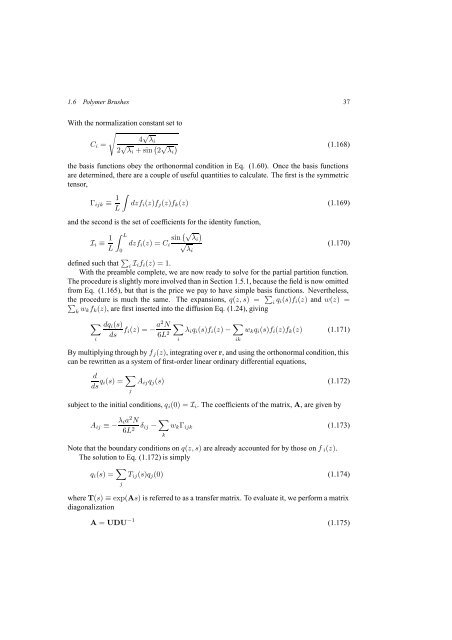Self-Consistent Field Theory and Its Applications by M. W. Matsen
Self-Consistent Field Theory and Its Applications by M. W. Matsen
Self-Consistent Field Theory and Its Applications by M. W. Matsen
You also want an ePaper? Increase the reach of your titles
YUMPU automatically turns print PDFs into web optimized ePapers that Google loves.
1.6 Polymer Brushes 37<br />
With the normalization constant set to<br />
√<br />
4 √ λ i<br />
C i =<br />
2 √ λ i +sin ( 2 √ ) (1.168)<br />
λ i<br />
the basis functions obey the orthonormal condition in Eq. (1.60). Once the basis functions<br />
are determined, there are a couple of useful quantities to calculate. The first is the symmetric<br />
tensor,<br />
Γ ijk ≡ 1 ∫<br />
dzf i (z)f j (z)f k (z) (1.169)<br />
L<br />
<strong>and</strong> the second is the set of coefficients for the identity function,<br />
I i ≡ 1 ∫ L<br />
sin (√ )<br />
λ i<br />
dzf i (z) =C i √ (1.170)<br />
L 0<br />
λi<br />
defined such that ∑ i I if i (z) =1.<br />
With the preamble complete, we are now ready to solve for the partial partition function.<br />
The procedure is slightly more involved than in Section 1.5.1, because the field is now omitted<br />
from Eq. (1.165), but that is the price we pay to have simple basis functions. Nevertheless,<br />
the procedure is much the same. The expansions, q(z,s) = ∑ ∑<br />
i q i(s)f i (z) <strong>and</strong> w(z) =<br />
k w kf k (z), are first inserted into the diffusion Eq. (1.24), giving<br />
∑ dq i (s)<br />
ds<br />
f i(z) =− a2 N ∑<br />
6L 2 λ i q i (s)f i (z) − ∑ w k q i (s)f i (z)f k (z) (1.171)<br />
i<br />
i<br />
ik<br />
By multiplying through <strong>by</strong> f j (z), integrating over r, <strong>and</strong> using the orthonormal condition, this<br />
can be rewritten as a system of first-order linear ordinary differential equations,<br />
d<br />
ds q i(s) = ∑ j<br />
A ij q j (s) (1.172)<br />
subject to the initial conditions, q i (0) = I i . The coefficients of the matrix, A, are given <strong>by</strong><br />
A ij ≡− λ ia 2 N<br />
6L 2 δ ij − ∑ k<br />
w k Γ ijk (1.173)<br />
Note that the boundary conditions on q(z,s) are already accounted for <strong>by</strong> those on f i (z).<br />
The solution to Eq. (1.172) is simply<br />
q i (s) = ∑ j<br />
T ij (s)q j (0) (1.174)<br />
where T(s) ≡ exp(As) is referred to as a transfer matrix. To evaluate it, we perform a matrix<br />
diagonalization<br />
A = UDU −1 (1.175)
















